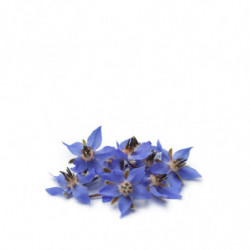- Out-of-Stock


Borage flowers are edible flowers characterized by their intense blue color and star-shaped form. They have a mild, sweet flavor reminiscent of cucumber and can be consumed both raw and cooked. Rich in vitamins, minerals, and antioxidants, they possess anti-inflammatory, detoxifying, and expectorant properties. Discover how to incorporate these flowers into your cooking to enhance your dishes with a touch of color and originality.
 Security policy
Security policy
Website built using newest versions, SSL protocols, Secure payments
 Delivery policy
Delivery policy
Receive your order in 24-48h
 Return policy
Return policy
100% Satisfaction guarantee

Guarantee safe & secure checkout
Borage flowers are edible flowers characterized by their intense blue color and star-shaped form. They have a mild, sweet flavor reminiscent of cucumber and can be consumed both raw and cooked. Rich in vitamins, minerals, and antioxidants, they possess anti-inflammatory, detoxifying, and expectorant properties. Discover how to integrate these flowers into your recipes to enhance both flavor and health.
Borage flowers come from the borage plant (Borago officinalis), an annual herb native to the Mediterranean. This plant, cultivated for its leaves and flowers, can reach up to one meter in height and has green leaves covered with white hairs. In addition to its culinary value, borage is used as a medicinal plant for its multiple health benefits.
Common Borage (Borago officinalis): The most well-known and cultivated variety, with intense blue flowers and contrasting black stamens.
Variegated Borage (Borago officinalis Variegata): A mottled plant with blue flowers and green leaves speckled with white.
White Borage (Borago officinalis Alba): Characterized by its intense white flowers and sturdy stems.
Creeping Borage (Borago pygmaea): A short-lived perennial plant with pale blue, fragrant flowers that spread along the ground.
Borage flowers can be easily grown in the garden or in pots, requiring a sunny spot and well-drained soil. They are sown directly into the ground or in seedbeds in early spring. Flowers appear between June and September and can be harvested when fully open. It is important to wash them thoroughly before consuming or drying to preserve them.